Drug Abuse: Ecstasy, Harm Minimisation, and Prevention Strategies
VerifiedAdded on 2021/01/01
|9
|2888
|141
Report
AI Summary
This report delves into the issue of ecstasy drug abuse, exploring its impact on individuals and society, with a specific focus on the Australian context. It begins by defining ecstasy (MDMA) and providing a brief history of its use, highlighting its classification as an illegal stimulant with potentially hallucinogenic properties and its association with poly-drug abuse. The report then examines harm minimization programs both in Australia and internationally, emphasizing the goals of reducing the harmful effects of drugs and alcohol. It outlines the key pillars of these programs, including reducing supply, demand, and harm, and discusses specific initiatives like needle and syringe programs and international labeling efforts. The report also analyzes barriers to prevention, such as social, cultural, and political factors, while also highlighting the benefits of prevention through education and community-based programs. Recommendations are offered to improve the effectiveness of harm minimization and prevention strategies. The report underscores the importance of a multi-faceted approach involving education, community engagement, and policy changes to combat the adverse effects of ecstasy and other drugs.
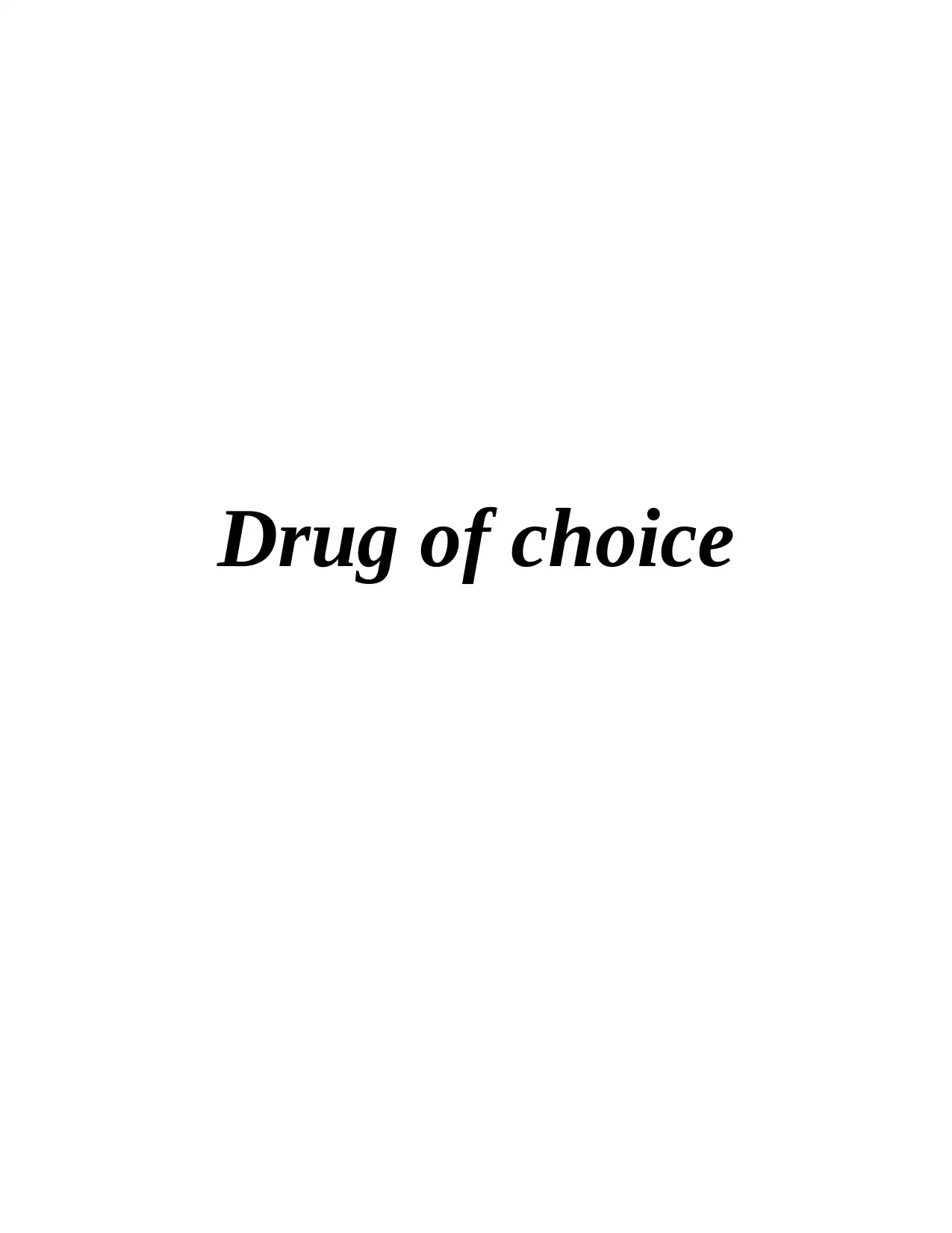
Drug of choice
Paraphrase This Document
Need a fresh take? Get an instant paraphrase of this document with our AI Paraphraser
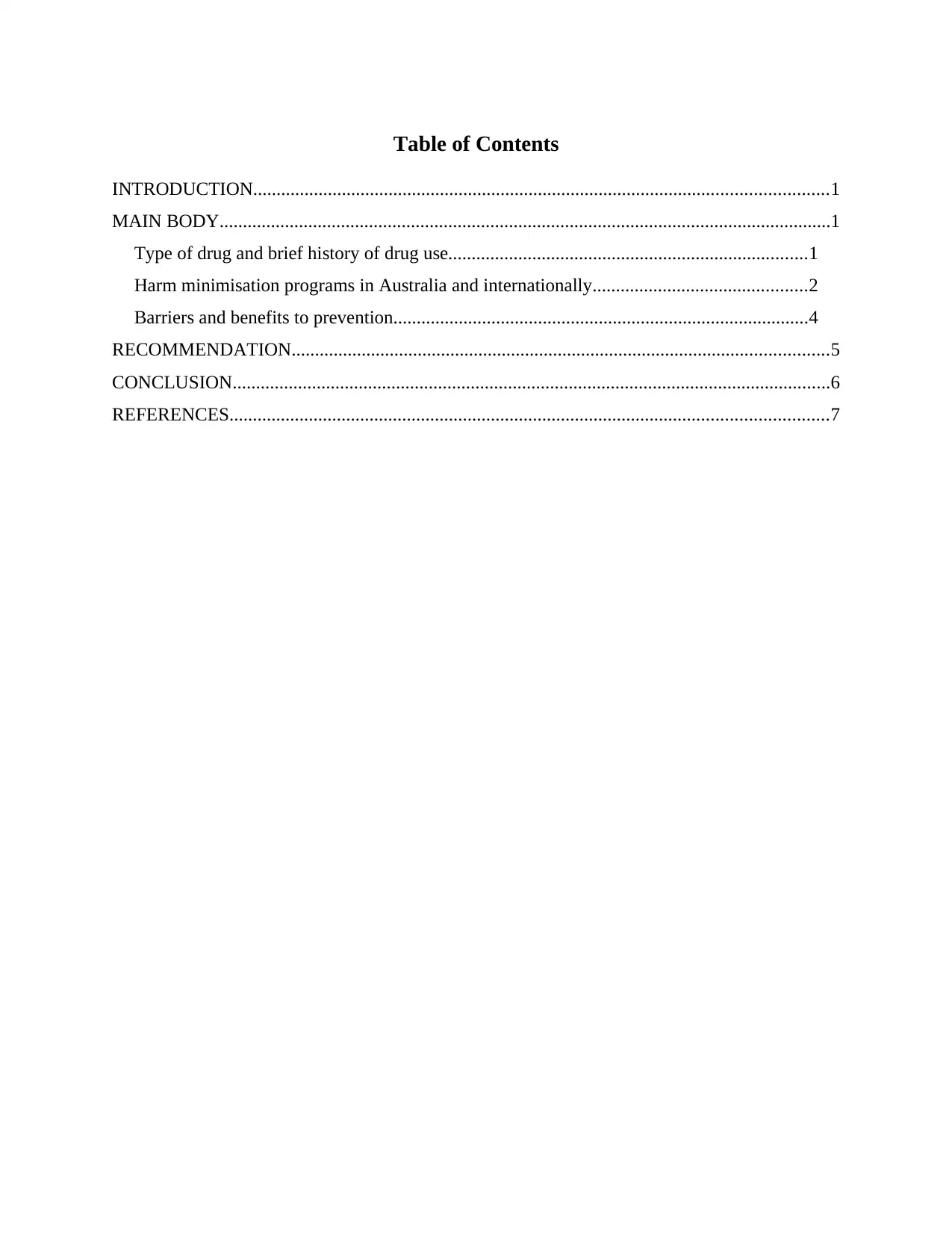
Table of Contents
INTRODUCTION...........................................................................................................................1
MAIN BODY...................................................................................................................................1
Type of drug and brief history of drug use.............................................................................1
Harm minimisation programs in Australia and internationally..............................................2
Barriers and benefits to prevention.........................................................................................4
RECOMMENDATION...................................................................................................................5
CONCLUSION................................................................................................................................6
REFERENCES................................................................................................................................7
INTRODUCTION...........................................................................................................................1
MAIN BODY...................................................................................................................................1
Type of drug and brief history of drug use.............................................................................1
Harm minimisation programs in Australia and internationally..............................................2
Barriers and benefits to prevention.........................................................................................4
RECOMMENDATION...................................................................................................................5
CONCLUSION................................................................................................................................6
REFERENCES................................................................................................................................7
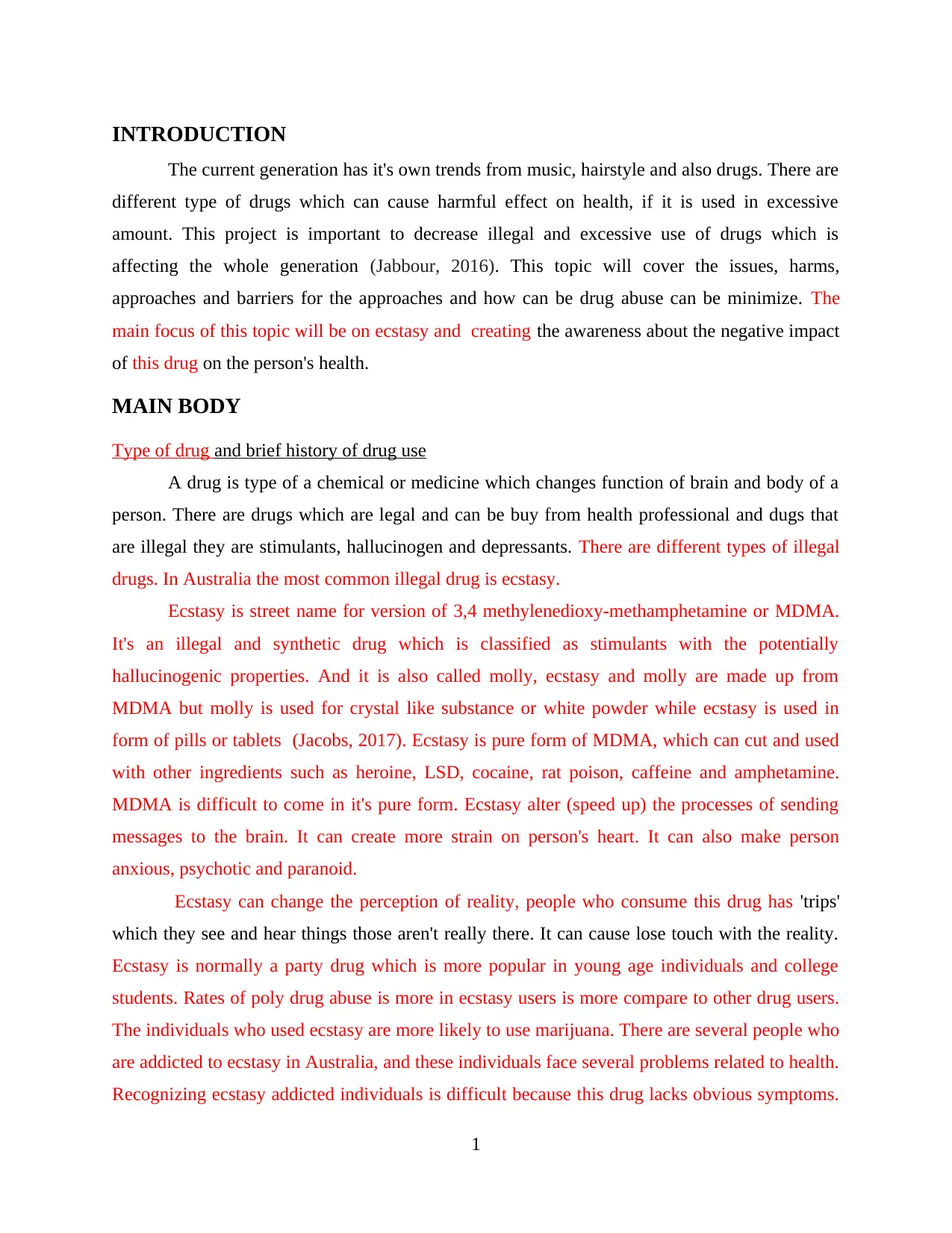
INTRODUCTION
The current generation has it's own trends from music, hairstyle and also drugs. There are
different type of drugs which can cause harmful effect on health, if it is used in excessive
amount. This project is important to decrease illegal and excessive use of drugs which is
affecting the whole generation (Jabbour, 2016). This topic will cover the issues, harms,
approaches and barriers for the approaches and how can be drug abuse can be minimize. The
main focus of this topic will be on ecstasy and creating the awareness about the negative impact
of this drug on the person's health.
MAIN BODY
Type of drug and brief history of drug use
A drug is type of a chemical or medicine which changes function of brain and body of a
person. There are drugs which are legal and can be buy from health professional and dugs that
are illegal they are stimulants, hallucinogen and depressants. There are different types of illegal
drugs. In Australia the most common illegal drug is ecstasy.
Ecstasy is street name for version of 3,4 methylenedioxy-methamphetamine or MDMA.
It's an illegal and synthetic drug which is classified as stimulants with the potentially
hallucinogenic properties. And it is also called molly, ecstasy and molly are made up from
MDMA but molly is used for crystal like substance or white powder while ecstasy is used in
form of pills or tablets (Jacobs, 2017). Ecstasy is pure form of MDMA, which can cut and used
with other ingredients such as heroine, LSD, cocaine, rat poison, caffeine and amphetamine.
MDMA is difficult to come in it's pure form. Ecstasy alter (speed up) the processes of sending
messages to the brain. It can create more strain on person's heart. It can also make person
anxious, psychotic and paranoid.
Ecstasy can change the perception of reality, people who consume this drug has 'trips'
which they see and hear things those aren't really there. It can cause lose touch with the reality.
Ecstasy is normally a party drug which is more popular in young age individuals and college
students. Rates of poly drug abuse is more in ecstasy users is more compare to other drug users.
The individuals who used ecstasy are more likely to use marijuana. There are several people who
are addicted to ecstasy in Australia, and these individuals face several problems related to health.
Recognizing ecstasy addicted individuals is difficult because this drug lacks obvious symptoms.
1
The current generation has it's own trends from music, hairstyle and also drugs. There are
different type of drugs which can cause harmful effect on health, if it is used in excessive
amount. This project is important to decrease illegal and excessive use of drugs which is
affecting the whole generation (Jabbour, 2016). This topic will cover the issues, harms,
approaches and barriers for the approaches and how can be drug abuse can be minimize. The
main focus of this topic will be on ecstasy and creating the awareness about the negative impact
of this drug on the person's health.
MAIN BODY
Type of drug and brief history of drug use
A drug is type of a chemical or medicine which changes function of brain and body of a
person. There are drugs which are legal and can be buy from health professional and dugs that
are illegal they are stimulants, hallucinogen and depressants. There are different types of illegal
drugs. In Australia the most common illegal drug is ecstasy.
Ecstasy is street name for version of 3,4 methylenedioxy-methamphetamine or MDMA.
It's an illegal and synthetic drug which is classified as stimulants with the potentially
hallucinogenic properties. And it is also called molly, ecstasy and molly are made up from
MDMA but molly is used for crystal like substance or white powder while ecstasy is used in
form of pills or tablets (Jacobs, 2017). Ecstasy is pure form of MDMA, which can cut and used
with other ingredients such as heroine, LSD, cocaine, rat poison, caffeine and amphetamine.
MDMA is difficult to come in it's pure form. Ecstasy alter (speed up) the processes of sending
messages to the brain. It can create more strain on person's heart. It can also make person
anxious, psychotic and paranoid.
Ecstasy can change the perception of reality, people who consume this drug has 'trips'
which they see and hear things those aren't really there. It can cause lose touch with the reality.
Ecstasy is normally a party drug which is more popular in young age individuals and college
students. Rates of poly drug abuse is more in ecstasy users is more compare to other drug users.
The individuals who used ecstasy are more likely to use marijuana. There are several people who
are addicted to ecstasy in Australia, and these individuals face several problems related to health.
Recognizing ecstasy addicted individuals is difficult because this drug lacks obvious symptoms.
1
⊘ This is a preview!⊘
Do you want full access?
Subscribe today to unlock all pages.

Trusted by 1+ million students worldwide
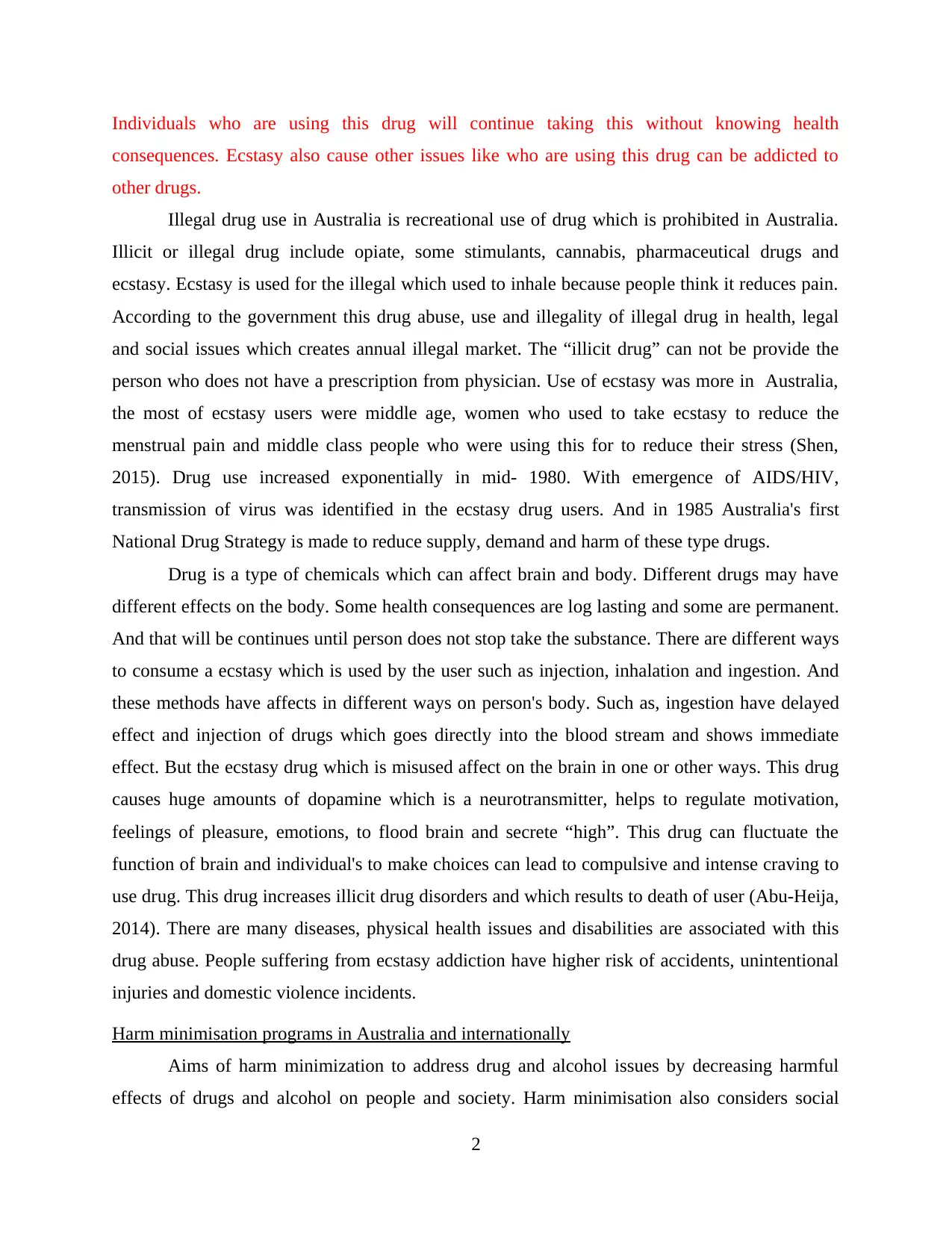
Individuals who are using this drug will continue taking this without knowing health
consequences. Ecstasy also cause other issues like who are using this drug can be addicted to
other drugs.
Illegal drug use in Australia is recreational use of drug which is prohibited in Australia.
Illicit or illegal drug include opiate, some stimulants, cannabis, pharmaceutical drugs and
ecstasy. Ecstasy is used for the illegal which used to inhale because people think it reduces pain.
According to the government this drug abuse, use and illegality of illegal drug in health, legal
and social issues which creates annual illegal market. The “illicit drug” can not be provide the
person who does not have a prescription from physician. Use of ecstasy was more in Australia,
the most of ecstasy users were middle age, women who used to take ecstasy to reduce the
menstrual pain and middle class people who were using this for to reduce their stress (Shen,
2015). Drug use increased exponentially in mid- 1980. With emergence of AIDS/HIV,
transmission of virus was identified in the ecstasy drug users. And in 1985 Australia's first
National Drug Strategy is made to reduce supply, demand and harm of these type drugs.
Drug is a type of chemicals which can affect brain and body. Different drugs may have
different effects on the body. Some health consequences are log lasting and some are permanent.
And that will be continues until person does not stop take the substance. There are different ways
to consume a ecstasy which is used by the user such as injection, inhalation and ingestion. And
these methods have affects in different ways on person's body. Such as, ingestion have delayed
effect and injection of drugs which goes directly into the blood stream and shows immediate
effect. But the ecstasy drug which is misused affect on the brain in one or other ways. This drug
causes huge amounts of dopamine which is a neurotransmitter, helps to regulate motivation,
feelings of pleasure, emotions, to flood brain and secrete “high”. This drug can fluctuate the
function of brain and individual's to make choices can lead to compulsive and intense craving to
use drug. This drug increases illicit drug disorders and which results to death of user (Abu-Heija,
2014). There are many diseases, physical health issues and disabilities are associated with this
drug abuse. People suffering from ecstasy addiction have higher risk of accidents, unintentional
injuries and domestic violence incidents.
Harm minimisation programs in Australia and internationally
Aims of harm minimization to address drug and alcohol issues by decreasing harmful
effects of drugs and alcohol on people and society. Harm minimisation also considers social
2
consequences. Ecstasy also cause other issues like who are using this drug can be addicted to
other drugs.
Illegal drug use in Australia is recreational use of drug which is prohibited in Australia.
Illicit or illegal drug include opiate, some stimulants, cannabis, pharmaceutical drugs and
ecstasy. Ecstasy is used for the illegal which used to inhale because people think it reduces pain.
According to the government this drug abuse, use and illegality of illegal drug in health, legal
and social issues which creates annual illegal market. The “illicit drug” can not be provide the
person who does not have a prescription from physician. Use of ecstasy was more in Australia,
the most of ecstasy users were middle age, women who used to take ecstasy to reduce the
menstrual pain and middle class people who were using this for to reduce their stress (Shen,
2015). Drug use increased exponentially in mid- 1980. With emergence of AIDS/HIV,
transmission of virus was identified in the ecstasy drug users. And in 1985 Australia's first
National Drug Strategy is made to reduce supply, demand and harm of these type drugs.
Drug is a type of chemicals which can affect brain and body. Different drugs may have
different effects on the body. Some health consequences are log lasting and some are permanent.
And that will be continues until person does not stop take the substance. There are different ways
to consume a ecstasy which is used by the user such as injection, inhalation and ingestion. And
these methods have affects in different ways on person's body. Such as, ingestion have delayed
effect and injection of drugs which goes directly into the blood stream and shows immediate
effect. But the ecstasy drug which is misused affect on the brain in one or other ways. This drug
causes huge amounts of dopamine which is a neurotransmitter, helps to regulate motivation,
feelings of pleasure, emotions, to flood brain and secrete “high”. This drug can fluctuate the
function of brain and individual's to make choices can lead to compulsive and intense craving to
use drug. This drug increases illicit drug disorders and which results to death of user (Abu-Heija,
2014). There are many diseases, physical health issues and disabilities are associated with this
drug abuse. People suffering from ecstasy addiction have higher risk of accidents, unintentional
injuries and domestic violence incidents.
Harm minimisation programs in Australia and internationally
Aims of harm minimization to address drug and alcohol issues by decreasing harmful
effects of drugs and alcohol on people and society. Harm minimisation also considers social
2
Paraphrase This Document
Need a fresh take? Get an instant paraphrase of this document with our AI Paraphraser
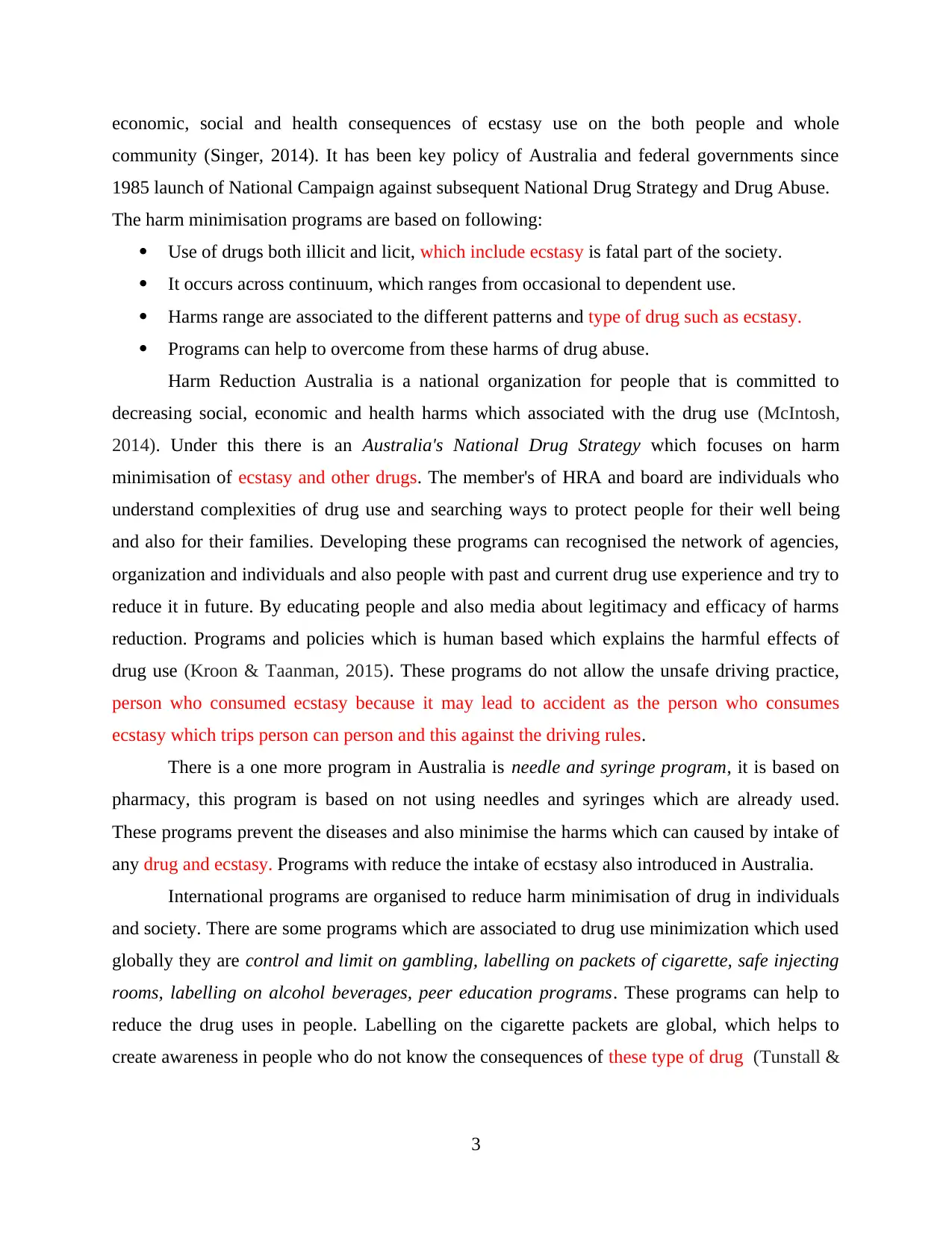
economic, social and health consequences of ecstasy use on the both people and whole
community (Singer, 2014). It has been key policy of Australia and federal governments since
1985 launch of National Campaign against subsequent National Drug Strategy and Drug Abuse.
The harm minimisation programs are based on following:
Use of drugs both illicit and licit, which include ecstasy is fatal part of the society.
It occurs across continuum, which ranges from occasional to dependent use.
Harms range are associated to the different patterns and type of drug such as ecstasy.
Programs can help to overcome from these harms of drug abuse.
Harm Reduction Australia is a national organization for people that is committed to
decreasing social, economic and health harms which associated with the drug use (McIntosh,
2014). Under this there is an Australia's National Drug Strategy which focuses on harm
minimisation of ecstasy and other drugs. The member's of HRA and board are individuals who
understand complexities of drug use and searching ways to protect people for their well being
and also for their families. Developing these programs can recognised the network of agencies,
organization and individuals and also people with past and current drug use experience and try to
reduce it in future. By educating people and also media about legitimacy and efficacy of harms
reduction. Programs and policies which is human based which explains the harmful effects of
drug use (Kroon & Taanman, 2015). These programs do not allow the unsafe driving practice,
person who consumed ecstasy because it may lead to accident as the person who consumes
ecstasy which trips person can person and this against the driving rules.
There is a one more program in Australia is needle and syringe program, it is based on
pharmacy, this program is based on not using needles and syringes which are already used.
These programs prevent the diseases and also minimise the harms which can caused by intake of
any drug and ecstasy. Programs with reduce the intake of ecstasy also introduced in Australia.
International programs are organised to reduce harm minimisation of drug in individuals
and society. There are some programs which are associated to drug use minimization which used
globally they are control and limit on gambling, labelling on packets of cigarette, safe injecting
rooms, labelling on alcohol beverages, peer education programs. These programs can help to
reduce the drug uses in people. Labelling on the cigarette packets are global, which helps to
create awareness in people who do not know the consequences of these type of drug (Tunstall &
3
community (Singer, 2014). It has been key policy of Australia and federal governments since
1985 launch of National Campaign against subsequent National Drug Strategy and Drug Abuse.
The harm minimisation programs are based on following:
Use of drugs both illicit and licit, which include ecstasy is fatal part of the society.
It occurs across continuum, which ranges from occasional to dependent use.
Harms range are associated to the different patterns and type of drug such as ecstasy.
Programs can help to overcome from these harms of drug abuse.
Harm Reduction Australia is a national organization for people that is committed to
decreasing social, economic and health harms which associated with the drug use (McIntosh,
2014). Under this there is an Australia's National Drug Strategy which focuses on harm
minimisation of ecstasy and other drugs. The member's of HRA and board are individuals who
understand complexities of drug use and searching ways to protect people for their well being
and also for their families. Developing these programs can recognised the network of agencies,
organization and individuals and also people with past and current drug use experience and try to
reduce it in future. By educating people and also media about legitimacy and efficacy of harms
reduction. Programs and policies which is human based which explains the harmful effects of
drug use (Kroon & Taanman, 2015). These programs do not allow the unsafe driving practice,
person who consumed ecstasy because it may lead to accident as the person who consumes
ecstasy which trips person can person and this against the driving rules.
There is a one more program in Australia is needle and syringe program, it is based on
pharmacy, this program is based on not using needles and syringes which are already used.
These programs prevent the diseases and also minimise the harms which can caused by intake of
any drug and ecstasy. Programs with reduce the intake of ecstasy also introduced in Australia.
International programs are organised to reduce harm minimisation of drug in individuals
and society. There are some programs which are associated to drug use minimization which used
globally they are control and limit on gambling, labelling on packets of cigarette, safe injecting
rooms, labelling on alcohol beverages, peer education programs. These programs can help to
reduce the drug uses in people. Labelling on the cigarette packets are global, which helps to
create awareness in people who do not know the consequences of these type of drug (Tunstall &
3
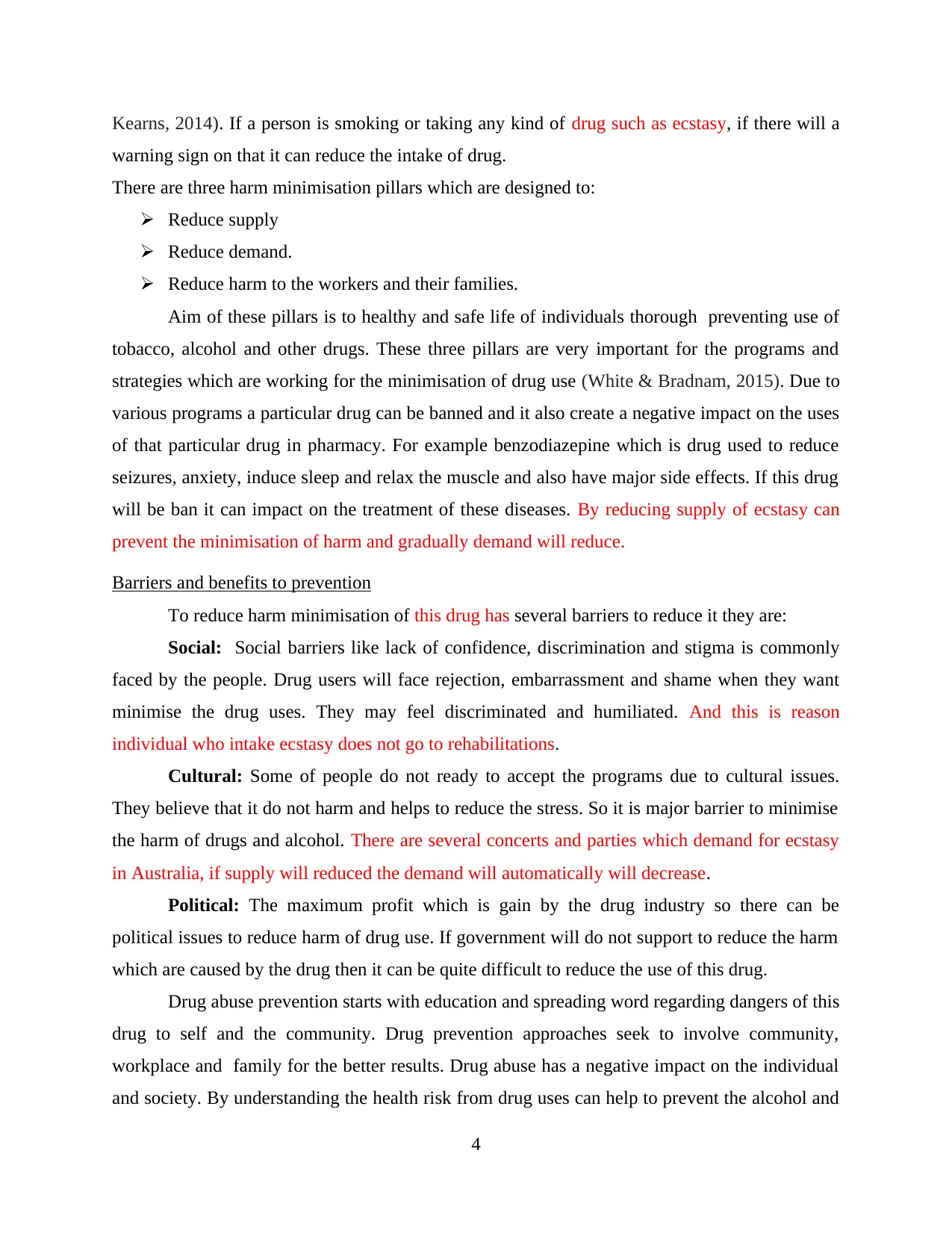
Kearns, 2014). If a person is smoking or taking any kind of drug such as ecstasy, if there will a
warning sign on that it can reduce the intake of drug.
There are three harm minimisation pillars which are designed to:
Reduce supply
Reduce demand.
Reduce harm to the workers and their families.
Aim of these pillars is to healthy and safe life of individuals thorough preventing use of
tobacco, alcohol and other drugs. These three pillars are very important for the programs and
strategies which are working for the minimisation of drug use (White & Bradnam, 2015). Due to
various programs a particular drug can be banned and it also create a negative impact on the uses
of that particular drug in pharmacy. For example benzodiazepine which is drug used to reduce
seizures, anxiety, induce sleep and relax the muscle and also have major side effects. If this drug
will be ban it can impact on the treatment of these diseases. By reducing supply of ecstasy can
prevent the minimisation of harm and gradually demand will reduce.
Barriers and benefits to prevention
To reduce harm minimisation of this drug has several barriers to reduce it they are:
Social: Social barriers like lack of confidence, discrimination and stigma is commonly
faced by the people. Drug users will face rejection, embarrassment and shame when they want
minimise the drug uses. They may feel discriminated and humiliated. And this is reason
individual who intake ecstasy does not go to rehabilitations.
Cultural: Some of people do not ready to accept the programs due to cultural issues.
They believe that it do not harm and helps to reduce the stress. So it is major barrier to minimise
the harm of drugs and alcohol. There are several concerts and parties which demand for ecstasy
in Australia, if supply will reduced the demand will automatically will decrease.
Political: The maximum profit which is gain by the drug industry so there can be
political issues to reduce harm of drug use. If government will do not support to reduce the harm
which are caused by the drug then it can be quite difficult to reduce the use of this drug.
Drug abuse prevention starts with education and spreading word regarding dangers of this
drug to self and the community. Drug prevention approaches seek to involve community,
workplace and family for the better results. Drug abuse has a negative impact on the individual
and society. By understanding the health risk from drug uses can help to prevent the alcohol and
4
warning sign on that it can reduce the intake of drug.
There are three harm minimisation pillars which are designed to:
Reduce supply
Reduce demand.
Reduce harm to the workers and their families.
Aim of these pillars is to healthy and safe life of individuals thorough preventing use of
tobacco, alcohol and other drugs. These three pillars are very important for the programs and
strategies which are working for the minimisation of drug use (White & Bradnam, 2015). Due to
various programs a particular drug can be banned and it also create a negative impact on the uses
of that particular drug in pharmacy. For example benzodiazepine which is drug used to reduce
seizures, anxiety, induce sleep and relax the muscle and also have major side effects. If this drug
will be ban it can impact on the treatment of these diseases. By reducing supply of ecstasy can
prevent the minimisation of harm and gradually demand will reduce.
Barriers and benefits to prevention
To reduce harm minimisation of this drug has several barriers to reduce it they are:
Social: Social barriers like lack of confidence, discrimination and stigma is commonly
faced by the people. Drug users will face rejection, embarrassment and shame when they want
minimise the drug uses. They may feel discriminated and humiliated. And this is reason
individual who intake ecstasy does not go to rehabilitations.
Cultural: Some of people do not ready to accept the programs due to cultural issues.
They believe that it do not harm and helps to reduce the stress. So it is major barrier to minimise
the harm of drugs and alcohol. There are several concerts and parties which demand for ecstasy
in Australia, if supply will reduced the demand will automatically will decrease.
Political: The maximum profit which is gain by the drug industry so there can be
political issues to reduce harm of drug use. If government will do not support to reduce the harm
which are caused by the drug then it can be quite difficult to reduce the use of this drug.
Drug abuse prevention starts with education and spreading word regarding dangers of this
drug to self and the community. Drug prevention approaches seek to involve community,
workplace and family for the better results. Drug abuse has a negative impact on the individual
and society. By understanding the health risk from drug uses can help to prevent the alcohol and
4
⊘ This is a preview!⊘
Do you want full access?
Subscribe today to unlock all pages.

Trusted by 1+ million students worldwide
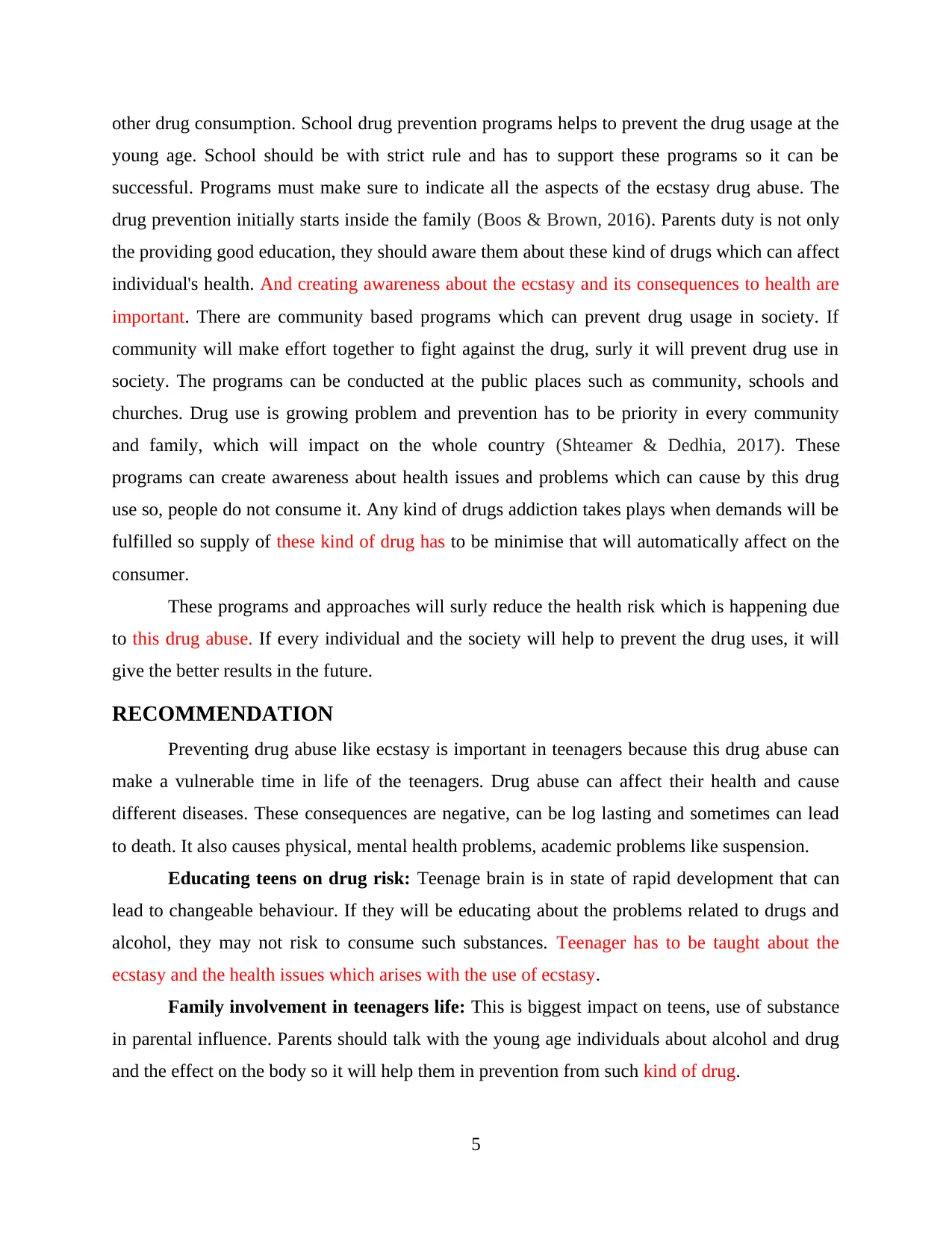
other drug consumption. School drug prevention programs helps to prevent the drug usage at the
young age. School should be with strict rule and has to support these programs so it can be
successful. Programs must make sure to indicate all the aspects of the ecstasy drug abuse. The
drug prevention initially starts inside the family (Boos & Brown, 2016). Parents duty is not only
the providing good education, they should aware them about these kind of drugs which can affect
individual's health. And creating awareness about the ecstasy and its consequences to health are
important. There are community based programs which can prevent drug usage in society. If
community will make effort together to fight against the drug, surly it will prevent drug use in
society. The programs can be conducted at the public places such as community, schools and
churches. Drug use is growing problem and prevention has to be priority in every community
and family, which will impact on the whole country (Shteamer & Dedhia, 2017). These
programs can create awareness about health issues and problems which can cause by this drug
use so, people do not consume it. Any kind of drugs addiction takes plays when demands will be
fulfilled so supply of these kind of drug has to be minimise that will automatically affect on the
consumer.
These programs and approaches will surly reduce the health risk which is happening due
to this drug abuse. If every individual and the society will help to prevent the drug uses, it will
give the better results in the future.
RECOMMENDATION
Preventing drug abuse like ecstasy is important in teenagers because this drug abuse can
make a vulnerable time in life of the teenagers. Drug abuse can affect their health and cause
different diseases. These consequences are negative, can be log lasting and sometimes can lead
to death. It also causes physical, mental health problems, academic problems like suspension.
Educating teens on drug risk: Teenage brain is in state of rapid development that can
lead to changeable behaviour. If they will be educating about the problems related to drugs and
alcohol, they may not risk to consume such substances. Teenager has to be taught about the
ecstasy and the health issues which arises with the use of ecstasy.
Family involvement in teenagers life: This is biggest impact on teens, use of substance
in parental influence. Parents should talk with the young age individuals about alcohol and drug
and the effect on the body so it will help them in prevention from such kind of drug.
5
young age. School should be with strict rule and has to support these programs so it can be
successful. Programs must make sure to indicate all the aspects of the ecstasy drug abuse. The
drug prevention initially starts inside the family (Boos & Brown, 2016). Parents duty is not only
the providing good education, they should aware them about these kind of drugs which can affect
individual's health. And creating awareness about the ecstasy and its consequences to health are
important. There are community based programs which can prevent drug usage in society. If
community will make effort together to fight against the drug, surly it will prevent drug use in
society. The programs can be conducted at the public places such as community, schools and
churches. Drug use is growing problem and prevention has to be priority in every community
and family, which will impact on the whole country (Shteamer & Dedhia, 2017). These
programs can create awareness about health issues and problems which can cause by this drug
use so, people do not consume it. Any kind of drugs addiction takes plays when demands will be
fulfilled so supply of these kind of drug has to be minimise that will automatically affect on the
consumer.
These programs and approaches will surly reduce the health risk which is happening due
to this drug abuse. If every individual and the society will help to prevent the drug uses, it will
give the better results in the future.
RECOMMENDATION
Preventing drug abuse like ecstasy is important in teenagers because this drug abuse can
make a vulnerable time in life of the teenagers. Drug abuse can affect their health and cause
different diseases. These consequences are negative, can be log lasting and sometimes can lead
to death. It also causes physical, mental health problems, academic problems like suspension.
Educating teens on drug risk: Teenage brain is in state of rapid development that can
lead to changeable behaviour. If they will be educating about the problems related to drugs and
alcohol, they may not risk to consume such substances. Teenager has to be taught about the
ecstasy and the health issues which arises with the use of ecstasy.
Family involvement in teenagers life: This is biggest impact on teens, use of substance
in parental influence. Parents should talk with the young age individuals about alcohol and drug
and the effect on the body so it will help them in prevention from such kind of drug.
5
Paraphrase This Document
Need a fresh take? Get an instant paraphrase of this document with our AI Paraphraser
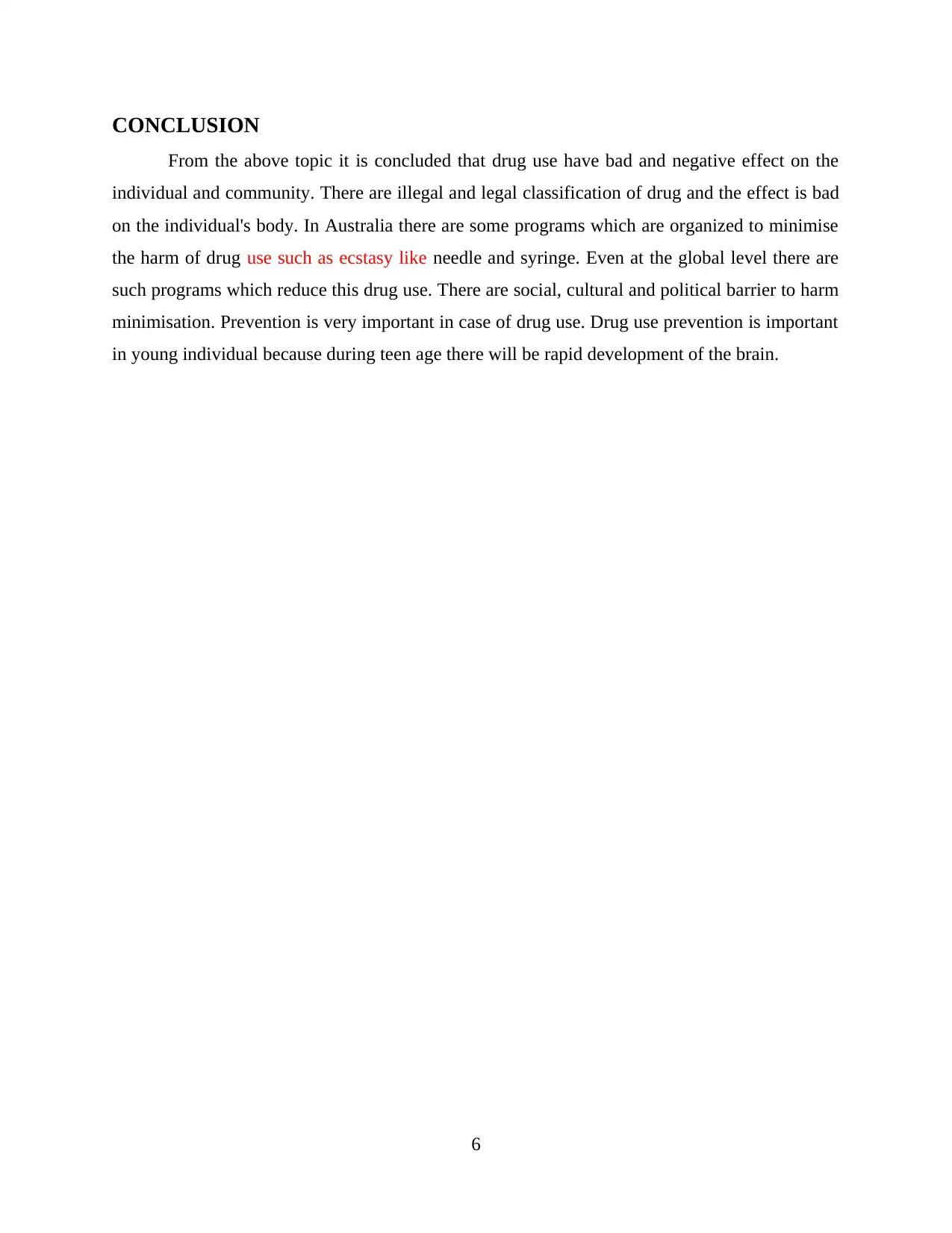
CONCLUSION
From the above topic it is concluded that drug use have bad and negative effect on the
individual and community. There are illegal and legal classification of drug and the effect is bad
on the individual's body. In Australia there are some programs which are organized to minimise
the harm of drug use such as ecstasy like needle and syringe. Even at the global level there are
such programs which reduce this drug use. There are social, cultural and political barrier to harm
minimisation. Prevention is very important in case of drug use. Drug use prevention is important
in young individual because during teen age there will be rapid development of the brain.
6
From the above topic it is concluded that drug use have bad and negative effect on the
individual and community. There are illegal and legal classification of drug and the effect is bad
on the individual's body. In Australia there are some programs which are organized to minimise
the harm of drug use such as ecstasy like needle and syringe. Even at the global level there are
such programs which reduce this drug use. There are social, cultural and political barrier to harm
minimisation. Prevention is very important in case of drug use. Drug use prevention is important
in young individual because during teen age there will be rapid development of the brain.
6
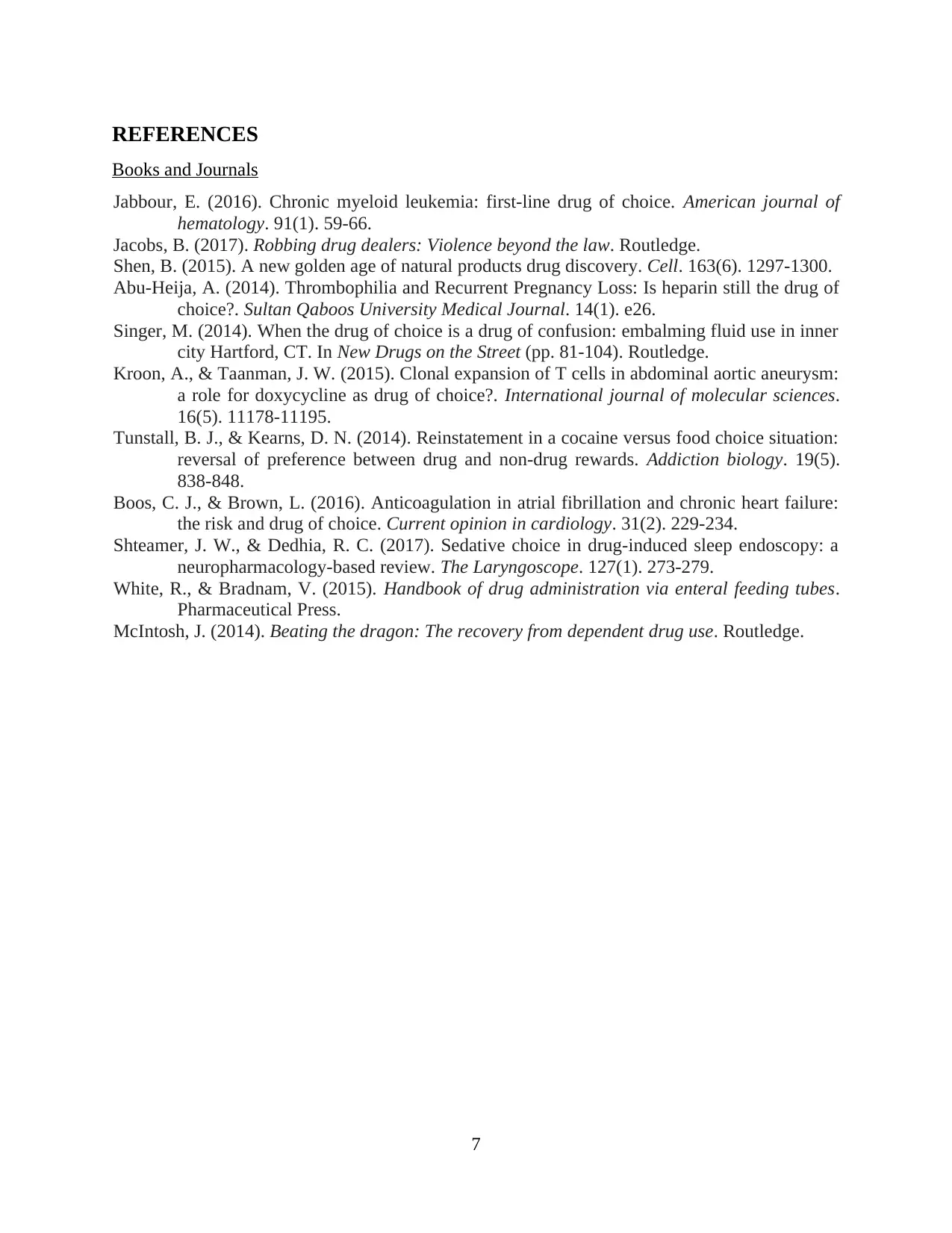
REFERENCES
Books and Journals
Jabbour, E. (2016). Chronic myeloid leukemia: first‐line drug of choice. American journal of
hematology. 91(1). 59-66.
Jacobs, B. (2017). Robbing drug dealers: Violence beyond the law. Routledge.
Shen, B. (2015). A new golden age of natural products drug discovery. Cell. 163(6). 1297-1300.
Abu-Heija, A. (2014). Thrombophilia and Recurrent Pregnancy Loss: Is heparin still the drug of
choice?. Sultan Qaboos University Medical Journal. 14(1). e26.
Singer, M. (2014). When the drug of choice is a drug of confusion: embalming fluid use in inner
city Hartford, CT. In New Drugs on the Street (pp. 81-104). Routledge.
Kroon, A., & Taanman, J. W. (2015). Clonal expansion of T cells in abdominal aortic aneurysm:
a role for doxycycline as drug of choice?. International journal of molecular sciences.
16(5). 11178-11195.
Tunstall, B. J., & Kearns, D. N. (2014). Reinstatement in a cocaine versus food choice situation:
reversal of preference between drug and non‐drug rewards. Addiction biology. 19(5).
838-848.
Boos, C. J., & Brown, L. (2016). Anticoagulation in atrial fibrillation and chronic heart failure:
the risk and drug of choice. Current opinion in cardiology. 31(2). 229-234.
Shteamer, J. W., & Dedhia, R. C. (2017). Sedative choice in drug‐induced sleep endoscopy: a
neuropharmacology‐based review. The Laryngoscope. 127(1). 273-279.
White, R., & Bradnam, V. (2015). Handbook of drug administration via enteral feeding tubes.
Pharmaceutical Press.
McIntosh, J. (2014). Beating the dragon: The recovery from dependent drug use. Routledge.
7
Books and Journals
Jabbour, E. (2016). Chronic myeloid leukemia: first‐line drug of choice. American journal of
hematology. 91(1). 59-66.
Jacobs, B. (2017). Robbing drug dealers: Violence beyond the law. Routledge.
Shen, B. (2015). A new golden age of natural products drug discovery. Cell. 163(6). 1297-1300.
Abu-Heija, A. (2014). Thrombophilia and Recurrent Pregnancy Loss: Is heparin still the drug of
choice?. Sultan Qaboos University Medical Journal. 14(1). e26.
Singer, M. (2014). When the drug of choice is a drug of confusion: embalming fluid use in inner
city Hartford, CT. In New Drugs on the Street (pp. 81-104). Routledge.
Kroon, A., & Taanman, J. W. (2015). Clonal expansion of T cells in abdominal aortic aneurysm:
a role for doxycycline as drug of choice?. International journal of molecular sciences.
16(5). 11178-11195.
Tunstall, B. J., & Kearns, D. N. (2014). Reinstatement in a cocaine versus food choice situation:
reversal of preference between drug and non‐drug rewards. Addiction biology. 19(5).
838-848.
Boos, C. J., & Brown, L. (2016). Anticoagulation in atrial fibrillation and chronic heart failure:
the risk and drug of choice. Current opinion in cardiology. 31(2). 229-234.
Shteamer, J. W., & Dedhia, R. C. (2017). Sedative choice in drug‐induced sleep endoscopy: a
neuropharmacology‐based review. The Laryngoscope. 127(1). 273-279.
White, R., & Bradnam, V. (2015). Handbook of drug administration via enteral feeding tubes.
Pharmaceutical Press.
McIntosh, J. (2014). Beating the dragon: The recovery from dependent drug use. Routledge.
7
⊘ This is a preview!⊘
Do you want full access?
Subscribe today to unlock all pages.

Trusted by 1+ million students worldwide
1 out of 9
Related Documents
Your All-in-One AI-Powered Toolkit for Academic Success.
+13062052269
info@desklib.com
Available 24*7 on WhatsApp / Email
![[object Object]](/_next/static/media/star-bottom.7253800d.svg)
Unlock your academic potential
Copyright © 2020–2025 A2Z Services. All Rights Reserved. Developed and managed by ZUCOL.




